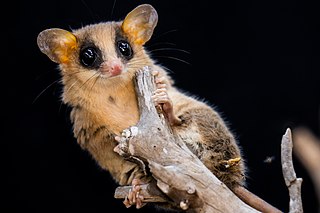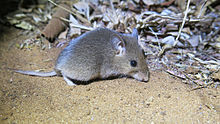
The common planigale, also known as the pygmy planigale or coastal planigale, is one of the small carnivorous marsupials known as "marsupial mice" found in Australia. There they fill a similar niche to the insectivores of other parts of the world.

The Muroidea are a large superfamily of rodents, including mice, rats, voles, hamsters, lemmings, gerbils, and many other relatives. Although the Muroidea originated in Eurasia, they occupy a vast variety of habitats on every continent except Antarctica. Some authorities have placed all members of this group into a single family, Muridae, due to difficulties in determining how the subfamilies are related to one another. Many of the families within the Muroidea superfamily have more variations between the families than between the different clades. A possible explanation for the variations in rodents is because of the location of these rodents; these changes could have been due to radiation or the overall environment they migrated to or originated in. The following taxonomy is based on recent well-supported molecular phylogenies.

Mouse-like hamsters, also called brush-tailed mice, are a group of small rodents found in Syria, Azerbaijan, Iran, Turkmenistan, Afghanistan, and Pakistan. They are found in rocky outcrops and semi-mountainous areas in desert regions.

The Nesomyidae are a family of African rodents in the large and complex superfamily Muroidea. It includes several subfamilies, all of which are native to either continental Africa or to Madagascar. Included in this family are Malagasy rodents, climbing mice, African rock mice, swamp mice, pouched rats, and the white-tailed rat.

Pouched rats are a group of African rodents in the subfamily Cricetomyinae. They are members of the family Nesomyidae, which contains other African muroids such as climbing mice, Malagasy mice, and the white-tailed rat. All nesomyids are in the superfamily Muroidea, a large and complex clade containing 1⁄4 of all mammal species. Sometimes the pouched rats are placed in the family Muridae along with all other members of the superfamily Muroidea.

Delany's mouse or Delany's swamp mouse is a species of rodent in the family Nesomyidae. It is the only species in the genus Delanymys and the only extant member of subfamily Delanymyinae, which also contains the fossil genus Stenodontomys. It was previously placed in subfamily Petromyscinae, but it is apparently not closely related to Petromyscus. It is found in Democratic Republic of the Congo, Rwanda, and Uganda. Its natural habitats are subtropical or tropical high-altitude shrubland and swamps. It is threatened by habitat loss.
Mearns's pouched mouse is a species of rodent in the family Nesomyidae. It is found in Ethiopia, Kenya, Somalia, Tanzania, and Uganda. Its natural habitats are dry savanna, subtropical or tropical dry shrubland, hot deserts, and arable land.
The tiny fat mouse is a species of rodent in the family Nesomyidae. It is found in Angola, Botswana, Ethiopia, Kenya, Mozambique, Namibia, South Sudan, Tanzania, Uganda, Zambia, and Zimbabwe. Its natural habitats are subtropical or tropical dry shrubland and subtropical or tropical dry lowland grassland.

The grayish or gray mouse opossum is a diminutive species of opossum in the family Didelphidae, endemic to Mexico. It is the sole species of its monotypic genus, Tlacuatzin.

Gracilinanus is a genus of opossum in the family Didelphidae. It was separated from the genus Marmosa in 1989, and has since had the genera Cryptonanus, Chacodelphys, and Hyladelphys removed from it.

The South African pouched mouse or southern African pouched mouse is a species of rodent in the family Nesomyidae, which is viewed as actually representing a complex of at least three undescribed species. It is found in southern Africa in Angola, Botswana, DR Congo, Malawi, Mozambique, Namibia, South Africa, Eswatini, Tanzania, Zambia and Zimbabwe. This species occurs in savanna woodland, as well as various other habitats, at elevations from 50 to 2000 m. It is present in arid regions of Namibia. The rodent is abundant and is tolerant of human disturbance of its habitat.









